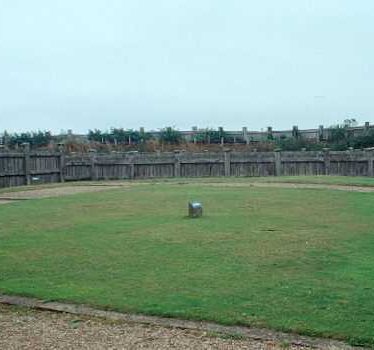The Lunt Roman Fort: Period 2
The Lunt, a fort that was rebuilt several times throughout the Roman period. During an excavation the remains of the defences, ovens, a gatehouse, granary and barracks were found from the second phase of occupation. It is situated north of Coventry Road, Baginton.
1 Excavation in 1966-7 indicated a second period of occupation within the late Neronian-early Flavian period (cAD 60-79). Period 2 is c70-90. Evidence was found for the W, E and possibly for the N defences, with associated rampart-ovens; also for a gateway, granary, barrack-block and a further building. Finds included coins, Samian, brooches, coarse ware, and military bronzes.
2 Further excavations 1968-71. Period 2 was more closely dated to cAD 64-70? The E gate was fully excavated, but S and W gates can only be inferred. Several buildings were excavated including a gyrus, principia, praetorium, two granaries and six barrack blocks. In addition two further Periods were distinguished (PRN 5298, 5299).
3 Further excavations after 1971 altered the dating of Phase 2 to cAD 64-77/8. Further work was conducted on a number of buildings within the fort. In addition a probable stable building was uncovered. The cumulative evidence of horse fittings, stabling (?), an extensive metalworking area, adequate granary and storage space, the gyrus and the size of the praetorium suggests a cavalry presence at the fort at this time. There is also possible evidence for cavalry training which could indicate the drafting of Britons into the Roman army.
5 Scheduled as Warwickshire Monument No 126.
8 Excavation in 1990-1 partly emptied the defensive ditches and revealed features suggesting a later palisade. There were also vestiges of occupation outside the defences. The line of the western defences continued to be uncovered as they met the NW corner of the fort.
9 The postulated mess hall and intervallum road identified in previous seasons must be discounted and only the the oven can securely be dated to the Roman period. The linear slot (see WA 2673), may belong to a period 1 building or a setting out slot for the period 2 rampart. It is certain that the period 2 inner ditch follows the line of a gravel bank and that the profile of this section of ditch appears not to be defensive in nature. The defensive system on the western side of the fort appears to be different from that on the eastern side, in having a triple ditch system.
10 Most of the work undertaken in the 1996 season was concentrated on the area to the W of the gravel bank, particularly the inner and wide ditches that form the western defences. It was concluded that the Period 2 inner ditch does follow the line of the gravel bank and its profile varies considerably; from a defensive ditch to the S to a U-shape, almost a U-shape, and then finally a fairly shallow ditch in the area of the present excavations. These changes may be due to topographic variations along the ditch’s course.
It seems that post-pits found along the edge of the gravel bank may well have formed a double row of timber emplacements, possibly part of a rampart structure. However, the relationship of the feature to the inner ditch would cause problems in the phasing and so it may be that the post pits are actually part of the Period 3 or even Period 4 rampart (WA 5298/WA 5299).
11 Work carried out during the 1997 season was again concentrated on the area to the W of the gravel bank, investigating the relationship between the outer, inner and wide ditches. Work in a section revealed that the wide ditch cut through the outer ditch and is therefore later. A sherd of medieval green glaze pot was found in the upper fill of the outer ditch, dating the wide ditch to the medieval period.
12 Excavations between 1988 and 1991 in the NW part of the fort found considerable plough disturbance. However, the line of the Period 2 rampart and part of the intervallum road was traced. A circular clay oven was discovered in 1991.
13 Continual cleaning of the area to the west of the outer ditch has gradually revealed a little more evidence of occupation in this area. Other than the ‘F’ and post hole buildings, very little has been found in this area, suggesting perhaps that it was sparsely inhabited. The occupation in the western part of the excavation may not be Roman but post Roman in date, or both.
14 Excavations of defensive ditches
15 Scheduling revision.
16 Scheduling information from 1978 showing additional area of the monument.
17 Report of work carried out in 2001.
18 Report of work from 1992.
- For the sources of these notes, see the
- Timetrail record
- produced by the Historic Environment Record.









Comments
Add a comment about this page